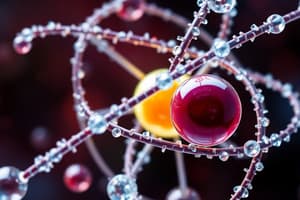Podcast
Questions and Answers
What is the atomic number?
What is the atomic number?
The number of protons in an atom's nucleus
Define isotopes.
Define isotopes.
Atoms with the same number of protons but different numbers of neutrons
Explain the Bohr model of the atom.
Explain the Bohr model of the atom.
Electrons orbit the nucleus in distinct energy levels or shells.
What does the quantum mechanical model describe?
What does the quantum mechanical model describe?
How is an atom's electron configuration determined?
How is an atom's electron configuration determined?
Flashcards are hidden until you start studying
Study Notes
Atomic Structure: A Comprehensive Overview
Atoms, the building blocks of all matter, are intricate structures that reveal fascinating details about our universe when we delve deeper. Let's explore the fundamental elements that make up an atom, starting with its basic components and moving forward to the intricate dance of electrons and protons.
The Nucleus
At the heart of every atom lies the nucleus, a compact region packed with protons and neutrons. Protons possess a positive charge, while neutrons are electrically neutral. The nucleus is held together by the strong nuclear force, which overcomes the electrostatic repulsion between protons.
The mass number (A) of an atom denotes the total number of protons and neutrons in its nucleus. The atomic number (Z) represents the number of protons.
Electrons
Surrounding the nucleus, we find electrons, tiny negatively charged particles that move in distinct energy levels, or shells. Electrons are arranged in atomic orbitals, which determine their behavior.
The arrangement of electrons follows Pauli's exclusion principle, which states that no two electrons can occupy the same quantum state simultaneously. Electrons fill energy levels from the lowest to the highest, and each energy level can hold a maximum of 2 electrons (one with each spin value).
Atomic Number and Periodic Table
The atomic number (Z) is the number of protons in an atom's nucleus and is directly related to the atom's chemical properties. Atoms with the same number of protons but different numbers of neutrons are called isotopes. The arrangement of atoms in the periodic table depends on their atomic number, electronic structure, and chemical properties.
The Bohr Model
The Bohr model is a simple but useful way to illustrate the arrangement of electrons in an atom. According to this model, electrons orbit the nucleus in distinct energy levels or shells. When an electron absorbs energy, it can move to a higher energy level, and when it loses energy, it moves down to a lower one.
Quantum Mechanical Model
The Bohr model is a simplified version of the quantum mechanical model, which describes electrons as probabilities distributed in space around the nucleus. According to this model, electrons occupy atomic orbitals, which are regions where the electron's probability of being found is high.
Orbital Shapes
The shape of atomic orbitals is defined by three quantum numbers: principal quantum number (n), angular momentum quantum number (l), and magnetic quantum number (m_l). Each of these numbers corresponds to a specific set of orbitals: n = 1, 2, 3, ... (s, p, d, f, ...), l = 0, 1, 2, ..., and m_l = -l, -(l-1), ..., l.
Electron Configuration
An atom's electron configuration describes how its electrons are distributed among atomic orbitals. To determine an atom's electron configuration, follow these steps:
- Fill the first shell (n = 1) with 2 electrons (in s orbitals).
- Fill the second shell (n = 2) with 8 electrons (4 in s orbitals and 4 in p orbitals).
- Fill the third shell (n = 3) with 8 electrons (2 in s orbitals, 6 in p orbitals).
- Continue this pattern for higher shells (d and f orbitals).
Ionization Energy and Electron Affinity
The ionization energy is the energy required to remove an electron from the outermost shell of an atom. The electron affinity is the energy released when an electron is added to a neutral atom. These properties are influenced by the type and arrangement of electrons and help determine an atom's reactivity.
Covalent Bonding and Chemical Bonds
Atoms form chemical bonds through the sharing or transfer of electrons. In covalent bonds, electrons are shared between atoms, forming molecular orbitals that hold the electrons.
Exploring the structure of an atom opens the door to a deeper understanding of the physical and chemical properties of matter. By understanding the interactions and arrangement of electrons, protons, and neutrons within an atom's nucleus, we can better understand the laws and principles that govern the behavior of all elements.
Studying That Suits You
Use AI to generate personalized quizzes and flashcards to suit your learning preferences.




